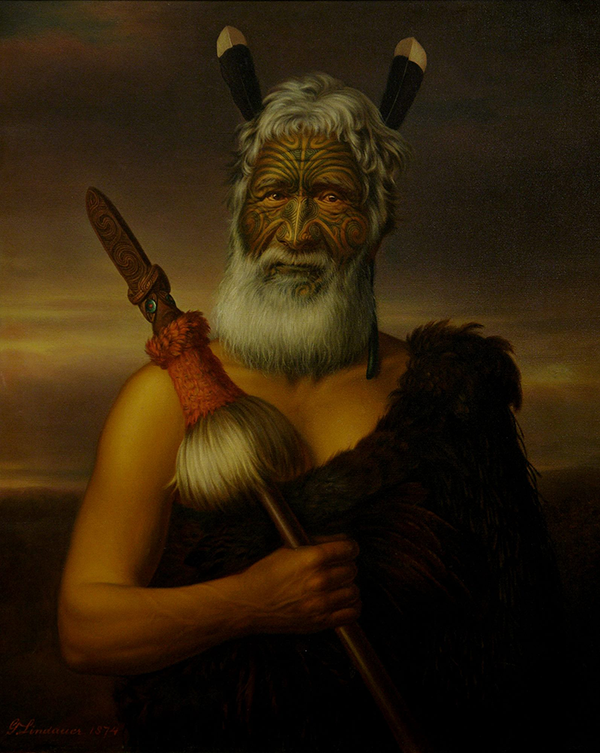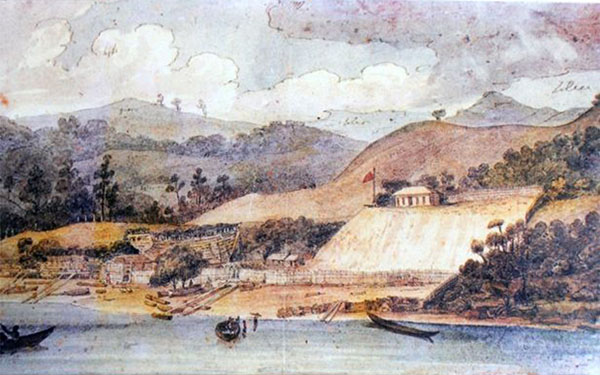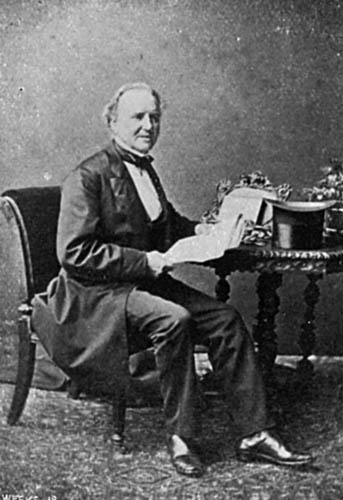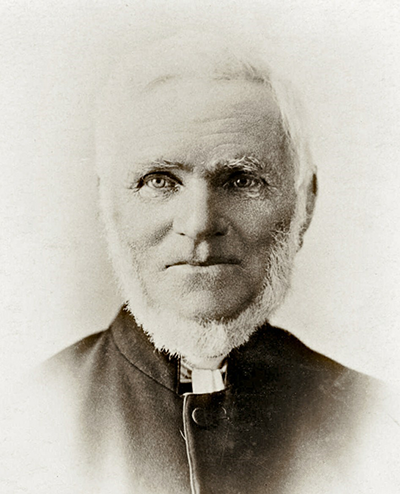The Moxon Brownes
Bob Moxon BrownePublished 2019
This online edition is a work in progress; captions here are tailored, and additional images are provided, for the Mahurangi Magazine audience
Chapter 9
Pages 69–84in printed edition
Octavius’s brother, Gordon Davis Browne
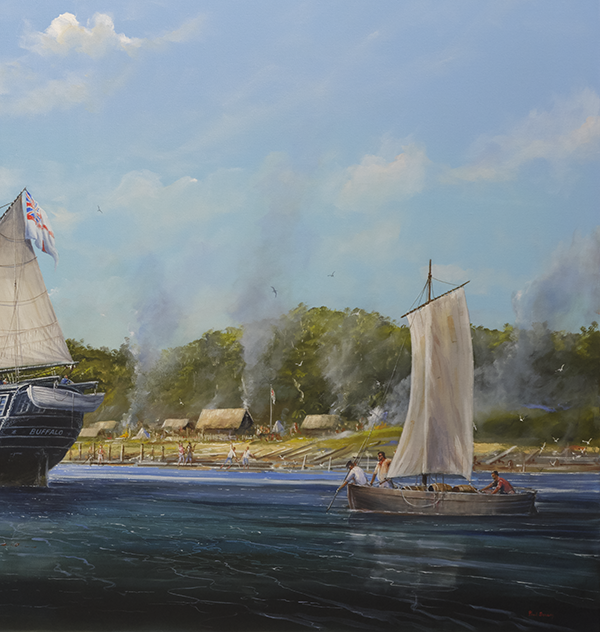
Moxon Browne-Inspired: Bob Moxon Browne kc’s request to the Mahurangi Magazine for assistance in sourcing images for this chapter resulted in the commissioning of the first known depiction of the first European settlement in the Auckland region, of which this section is a small part. marine artist Paul Deacon | caption Mahurangi Magazine
Gordon Davis Browne was born in early 1805, and baptised at St Mary’s Lambeth on 22 March that year. The explanation for his given name of Gordon is not known. Charles Gordon Browne—who was born in January 1845, and whose own second name was obviously a memorial to his recently deceased uncle Gordon—might have been expected to know the answer, but apparently did notCharles Gordon Browne does record that Gordon’s second name, Davis, came from his (unidentified) godmother. Gordon as a given name was unusual at this time, only becoming popular after the life and death of General Gordon of Khartoum in the second half of the 19th century.
Charles Browne states that:
…little is known of [Gordon’s] history beyond the fact that he went to New Zealand some time before 1832, and was still there in February 1840 when he had acquired great influence among the Māori chiefs…
In fact a great deal is now known about Gordon’s life and work in New Zealand, where he is today regarded as an important early settler, and particularly as the man largely responsible for establishing New Zealand’s timber export trade. A considerable amount of research material is available, from which details have emerged See especially Robert Brassey (2014) A Bay Where No Ships Have been: The History and Archaeology of Auckland’s First European Settlement, Part 1, The History of Browne’s Mahurangi Spar Station 1832-1836 (Unpublished Manuscript, Auckland Council, Auckland), referred to in this Chapter as Brassey; Roger Wigglesworth The New Zealand Timber and Flax Trade 1769-1840 (1981), referred to as Wigglesworth; and various articles and records published on-line in New Zealand, which are acknowledged individually in the course of this Chapter. which might have surprised Charles Browne.
One reason for the extent of recorded information about New Zealand’s early settlers, including Gordon Browne, is that their purchases of land from local Māori chiefs—in fact often bartered for trade goods—have since been the subject of repeated claims, investigations, commissions and reviews, in which the Māori people have themselves often played a key part. The evidence given in the course of these investigations has been extensively recorded, including, in the case of lands originally acquired by Gordon Browne, various examples of his business records and correspondence. To some extent arguments over rights to the Māori ancestral lands continue to this day, and the events of nearly two hundred years ago are still sometimes referred to in support of the Māori people’s continuing claimsThe Ngāti Pāoa iwi (tribe) have been particularly active in pressing rights connected with lands north of Auckland, including some land which may have been originally “sold” to Gordon Browne..
Most of the early settlement of New Zealand by Europeans was connected either with whaling, or with trade in timber. Following the disruption of Baltic commerce caused by the Napoleonic wars, good quality timber from Europe became scarce and expensive, and in the early 19th century, Britain’s Royal Navy in particular was looking for fresh sources of supply. The New Zealand pine, Agathis australis, or kauri, growing only in New Zealand’s North Island, was ideal for naval purposes, including the procurement of very long straight trunks for ships’ masts and spars.
However the business was very risky. The difficulty in abstracting and shipping the huge timbers required was considerable, and the navy’s specifications, especially for masts, were rigorous. If a spar was rejected for some defect, its commercial value could fall dramaticallySee generally Wigglesworth and Brassey. This was the highly precarious trade to which Gordon Browne was to devote much of his life. Charles Browne says nothing of Gordon’s early life or schooling. Although there is no specific evidence of it, it seems likely that Gordon accompanied his mother and siblings to St Omer in France in 1814, returning to England in 1815 in time for the birth of his nephew Hablot, shortly followed by his brother Decimus. When Gordon was aged no more than seventeen or eighteen, his father William Loder Browne deserted the family and emigrated to Philadelphia in the United States, where he set himself up as an artist. No doubt Gordon then realised that he was going to have to make his own way in the world, and in 1826 he set out for Australia.
It seems quite likely that his passage, and perhaps a small amount of capital to allow him to get started, was paid by the Moxons of Twickenham, who undoubtedly gave considerable help and support to the abandoned Browne family at this time.
Gordon Browne arrived in Sydney in June 1826Sydney Gazette, 7 June 1826, as Sydney agent for a London merchant, John MarshallSee Wigglesworth pp. 152–153. He then joined the Sydney firm of Raine and Ramsey, either as an employee, or possibly a partner, operating the so-called New Zealand Trading Wharf on their behalf.
At the firm’s request, in 1829, Gordon travelled to Hōreke, in the upper reaches of the Hokianga inlet, on the west coast of New Zealand’s North Island. The land and forests at Hokianga were under the control of a great Māori rangatirachieftain Patuone, one of the leaders of the locally dominant Ngāpui iwi. Patuone claimed with some conviction that as a young child he had been amongst those who had greeted Captain CookPatuone died in 1872 at a very advanced, but uncertain, age. If his story about meeting Captain Cook was true, he must have lived to well over 100. Wikipedia records that he was “at least 108” when he died. on his arrival in New Zealand in 1769. Patuone was a famous warrior in his youth, but in later years had gained a reputation as a peacemaker, and a man of commercial acumen who understood and befriended the Pākehā, the Māori word for European settlers.
Patuone welcomed Gordon at Hokianga, giving him protection, and bartering land and timber rights It is recorded that the original barter “price” was 2 muskets, one case of powder, four hoes, four axes and 10 pounds of powder. However it is likely that the commercial arrangements were rather more complicated, including Patuone’s involvement in the business as a quasi-partner. for Gordon’s business. Gordon soon established saw pits and a timber yard, as well as a small shipyard, the first of its kind in New Zealand. This was rather grandly named “Deptford Dockyard”, after the Navy’s dockyard on the Thames. Here Gordon constructed several ships, making use of timbers and a workforce both organised by Patuone. The largest of the vessels, and the last to be built, was a four-hundred-ton sailing barque called the Sir George Murray, owned by Ramsay, Raine and Browne, although Patuone also seems to have had a part interest.
During this period, Gordon found time to become fluent in the Māori language, properly referred to as te reo Māoriand, colloquially, as te reo: the language, and familiar with the Māori people and their culture.
While at Hokianga, Gordon met up with Captain Ranulph Dacre, a sea captain and merchant, who was also interested in the timber trade. A document dated 1st September 1829 recording the barter of land at Hokianga from local chiefs to the Wesleyan Missionary Society is witnessed by both Dacre and BrowneSee Hanson Turton Māori Deeds of Old Private Land Purchases 1815–1840. Dacre evidently formed a favourable impression of Gordon Browne, and they were later to go into business together. Unfortunately, Raine and Ramsey’s business failed. Raine was declared bankrupt in December 1828. Browne continued to manage the Hōreke timber yard, but he too became insolvent and was himself declared bankrupt in March 1830.
In November 1830 Gordon left Hokianga, sailing to Sydney, Australia in the Sir George Murray. He was accompanied by Patuone, and another rangatira from Hokianga, named Taonui. No doubt the Māori came along as sightseers, but also probably as mercantile ambassadors, keen to promote their own trading links between Hokianga and Sydney.
Browne’s maiden voyage in the Sir George Murray ended sadly. Carrying a cargo of timber and flax, and flying a Māori woven cloak in lieu of a flag, the ship was impounded by officials on its arrival in Sydney, and was auctioned with its cargo for the benefit of Raine’s creditors. The fate of the ship is evident from a newspaper advertisement for the saleSee Sydney Gazette, 18 January 1831, recording that it was:
…on account of the estate of Thomas Raine, to be sold with a quantity of squared spars, round logs and sawn timber, now lying at ShukiangaHokianga New Zealand.
This clear evidence of a sale for the benefit of a bankrupt estate is of some historical importance, because several accounts of New Zealand’s early colonial history have asserted that the reason for the impounding and sale of the Sir George Murray was that, in breach of maritime law, the vessel was not registered under the flag of any sovereign State, the Māori cloak at the mast head not answering this requirement. It has been said that this episode, and perhaps some others like it, provided some particular impetus to New Zealand’s march to sovereignty, eventually achieved by the Treaty of Waitangi in 1840.
Other historians have dismissed this thesis as a mythSee particularly Coralling Consent: An inquiry into the mythical beginning of the New Zealand Flag (Bevan Smith, 2016), pointing out that the impounding of the ship was clearly part of the sale of the whole of Gordon’s Hokianga establishment for the benefit of Raine’s creditors; and that Sydney merchants would probably have been reluctant to offend or insult Patuone and Taonui by failing to give official recognition to the existence of their homeland.
Be this as it may, Gordon’s place at Hokianga was soon taken over by the purchaser of the Sir George Murray, one Thomas McDonnell, whose business methods and dubious land claims were to earn him the nickname “McDiddle”. Despite this reputation, he gained the support of Patuone and Taonui, who were quick to recognise the status of the new colonist in their midst. In June 1831 the chiefs were persuaded to publish a formal document in English part of which read:
We the principal Chiefs of Hokianga in the Island of New Zealand PATUONE and TAONUI send greeting to say that Thomas MacDonnell, a Resident and Land holder in our country is the sole owner of the Barque or Vessel called the “Sir George Murray”, whereof the said Thomas MacDonnell now is Master, that the said Barque or Vessel called the “Sir George Murray” was built in OUR TERRITORIES of our Timber…
Her breadth at the broadest part above the main wales is twenty eight feet eight inches …. she is Barque rigged with a standing Bowsprit, is square sterned, Carvel built, has no galleries and a scroll figure head, was launched on the second day of September, one thousand eight hundred and thirty as the two Principal Chiefs PATUONE and TAONUI do hereby certify that the several particulars set forth in the above further certify that the aforesaid Thomas MacDonnell is entitled to all the privileges and immunities of a Chief at Hokianga in the Island of New Zealand.
Hokianga New Zealand 2nd June 1831
Meanwhile, Gordon did not let the grass grow under his feet. He returned to New Zealand’s North Island and he was for a short time engaged in the flax trade, based at Matakohe—Limestone IslandSee Friends of Matakohe—Limestone Island: The Island Story http://www.limestoneisland.org. nz/npages/story_history.html, in Whangārei Harbour. However, in January 1832 his establishment was burnt to the ground, probably the incidental victim of intertribal Māori warfare. Gordon arrived back in Sydney on 28 March 1832See Sydney Gazette, 29 March 1832, “insolvent [with] no means of his own [and] … barely sufficient clothes to cover himSee Dacre’s evidence to the Land Claims Court in Auckland 28 June 1862.”.
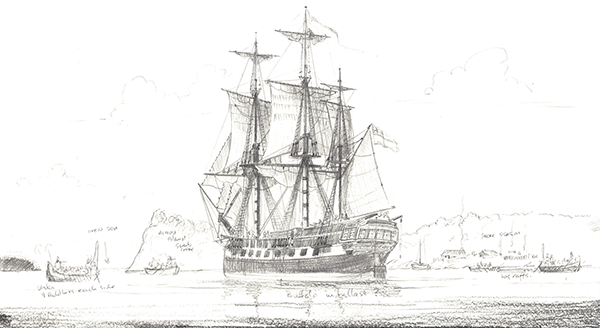
An immensely gratifying bonus of publishing the Mahurangi Magazine are the unanticipated consequences such as being contacted—in this instance—by this history’s author, seeking images relevant to Gordon Davis Browne’s Mahurangi spar station. The magnificently prolific marine artist Paul Deacon, when readily agreeing to allow his images to be reproduced herein, quipped, “Of course Bob Moxon Browne could commission his own private painting!” This modello and the subsequent painting, below, was the result of a Moxon Browne-led commissioning syndicate. The resultant hmss Buffalo off Spar Station Cove the first and only depiction of the first European settlement in what is now Auckland–Makaurau, New Zealand’s principal metropolis. A Moxon Browne prerequisite, however, that the finished work be exhibited in a public Mahurangi place has so far been thwarted by recent Auckland Council reticence to host depictions of European-settler activities. marine artist Paul Deacon | caption Mahurangi Magazine
Almost immediately, Gordon met up again with Captain Ranulph Dacre, who had experience of exploiting kauri timber resources at Mercury BaySo-named because in 1769 Captain Cook observed the Transit of Mercury (the planet Mercury passing between the earth and the sun) from this location., on the northeast coast of New Zealand’s North Island, as well as at Hokianga. Dacre was impressed with Gordon’s knowledge of te reo Māori and Māori culture, and arranged for him to return to New ZealandPrior to his departure on this new venture Gordon wrote to his Aunt Ann Moxon (at The Lodge Twickenham) regretting the “sad interruption” in their correspondence, due to the fact that “during the few years I have been in his hemisphere I have been for the most part in scenes of trouble”. to set up a kauri timber station at Mahurangi, on the east coast of the north island, about seventy miles south of the Bay of Islands.
Gordon sailed for New Zealand with Captain Dacre on 7 May 1832, arriving at Mahurangi Harbour on 21 May 1832. Gordon again acquired land from local chiefs of the Ngāti Pāoa iwi at or near a place still shown on modern maps as Browne’s Bay. Since Browne was effectively destitute at this time, it is likely that it was Dacre who actually paid for this land, or provided the trade goods used to barter for it. However, it must be said that the business relationship between the two men is unclear. In subsequent claims to the Land Claims Court in Auckland in 1862, Dacre did not dispute that it was Browne who had acquired these and other lands, but argued (in the event successfully) that because he had put up the funds, and Browne had died owing him money, he was entitled to the land “in equity”. It seems probable that Dacre and Browne agreed some kind of partnership, either formally or informally, by which Dacre put money into the enterprise, and Browne did most of the work.
It is recorded that while at Mahurangi, Gordon took a Māori wife, Jess, by whom he had a child. Jess was from the Ngāti Pāoa iwi, and related to local chiefs. In one of Browne’s subsequent land claims made in 1841 to the Colonial Secretary for New South Wales (“Claim No. 5” ) it was said that some of the land at Mahurangi had been gifted to Gordon Browne by the Ngāti PāoaThis information is given by Locker’s Jade River: A History of the Mahurangi Part 3 Gordon Browne and his Spar Station published by Mahurangi Magazine iwi chiefs:
…in trust for his child (now living) the mother of the child being a Native of New Zealand and a relative of the above-named chiefs”.
It is likely that this marriage was part of a wider agreement with Ngāti Pāoa chiefs, which would also have included arrangements about a workforce to fell and extract spars at an agreed rate to be paid in trade goods. BrasseyCiting Samuel McDonald Martin New Zealand in a Series of Letters, Simmonds & Ward, London 1845. explains that it was common for timber traders and other early settlers to take Māori wives, generally involving an arranged marriage with a woman of rank. This was seen as a way of cementing a relationship for the benefit of both sidesIn the course of Octavius Browne’s five month visit to his brother Gordon in New Zealand in 1839-40, described in Chapter 2 and below, Octavius appears to have received at least two serious offers of marriage from high- ranking daughters of Māori chiefs, in both cases the subject of an elaborate presentation of the benefits of the offer. It is apparent from Octavius’ description of these approaches that the prospective marriage was seen as highly advantageous from the Māori perspective. See Octavius’ letter to his cousin Eliza Moxon referred to below. There is a transcription of this long letter in CGB, and there is also a copy in the Mercury Bay Museum in New Zealand.—including, in the case of the Māori, guaranteed ongoing access to European trade.
“Jess” was certainly a woman of rank. Brassey has established that she was the daughter of the Ngāti Pāoa chief Rawiri Takarua, and also had ancestral links to Ngāti Tamaterā. Further research may yet provide details of her descendants, including any descendants of her child by Gordon Browne.
The missionary Henry Williams visiting Mahurangi in April 1833 recorded in his diary that timber work had commenced, with about thirty Māori workers employed; and by the Autumn of that year the first timber shipments had commenced. On 24 October 1833, the Sydney Herald reported that Dacre’s ship Surrey had docked with one hundred and ninety-six loads of timber and one hundred and eighty-six spars.
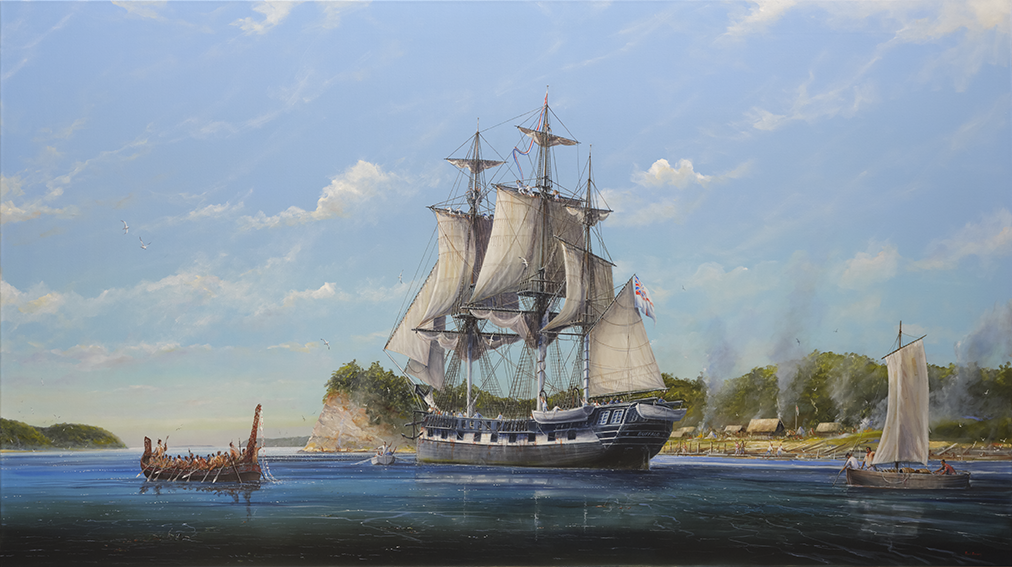
Imposing Presence: Given her draft, hm supplyship Buffalo probably never manoeuvred quite this far up the Mahurangi Harbour, but was placed in this commissioned scene because of the part she played in ensuring that the first European settlement in the Auckland region—Gordon Browne’s kauri extraction operation supplying spars to the Admiralty—was entirely short-lived. marine artist Paul Deacon | caption Mahurangi Magazine
However life was not easy. Shortly after setting up the Mahurangi station, Browne and Dacre left for Hokianga on the west coast of the island, where both had previously worked, hoping to recruit workers and arrange for provisions. While they were away, the Mahurangi station was raided by a rival timber trader, Joseph Weller, who claimed that one of Gordon’s managers, Joseph Kendall, owed him money. The rights and wrongs of the affair were tangled, but the upshot was that Weller made off with a substantial amount of Gordon Browne’s timber and trading goods, in his vessel the Lucy Ann, while Gordon ended up in possession of the Lucy Ann’s sailing cutter, which was probably a vessel of reasonably substantial value. Gordon Browne subsequently said that Weller’s claim that Kendall owed him money, was no more than a ruse to disrupt his trading operation. There seems no doubt that while Gordon showed considerable determination in trying to minimise the effects of the raid, it was a serious commercial set-back for the Mahurangi operation
The ins and outs of this incident are described in detail by Brassey, who cites a number of contemporaneous documents showing something of both sides of the story. Gordon Browne emerges from these accounts as a brave and resourceful man, whose position in defending his operation was strengthened through his ability to call on support from his loyal Māori workforce.
Leaving aside raids, whether from rival traders or warring tribesmen, trading conditions at Mahurangi were difficult, partly because of the distances over which felled timber had to be dragged to the harbour. Writing in 1834, Richard Hodgskin, steward to the purser of the Royal Navy ship Buffalo, which had called at Mahurangi to inspect the facilities for producing spars for the Navy, describes a labour-intensive process:
It was later claimed by both Gordon Browne and Captain Dacre that the arrival of the Buffalo constituted another set-back for the Mahurangi Spar Station, because the Navy commandeered the best timber for itself, to the detriment of Browne’s operation, paying the Māori wages which Browne could not compete with. However, it is hard to see how a single shipment on the Buffalo would have made much inroads in what was available. Wigglesworth saysSee Wigglesworth 126 that “separating fact and fiction from Browne’s correspondence with Dacre … is impossible”, and it may be that accounts of what had happened were for some reason distorted in the context of subsequent Browne and Dacre land claims. However, it is well-documented that Dacre later declared See Dacre’s evidence to Land Claims Court in Auckland 28 June 1862. that the Buffalo’s commandeering of Mahurangi spars was the reason why Dacre and Browne were to shift their timber operation from Mahurangi to Whitianga in Mercury Bay.
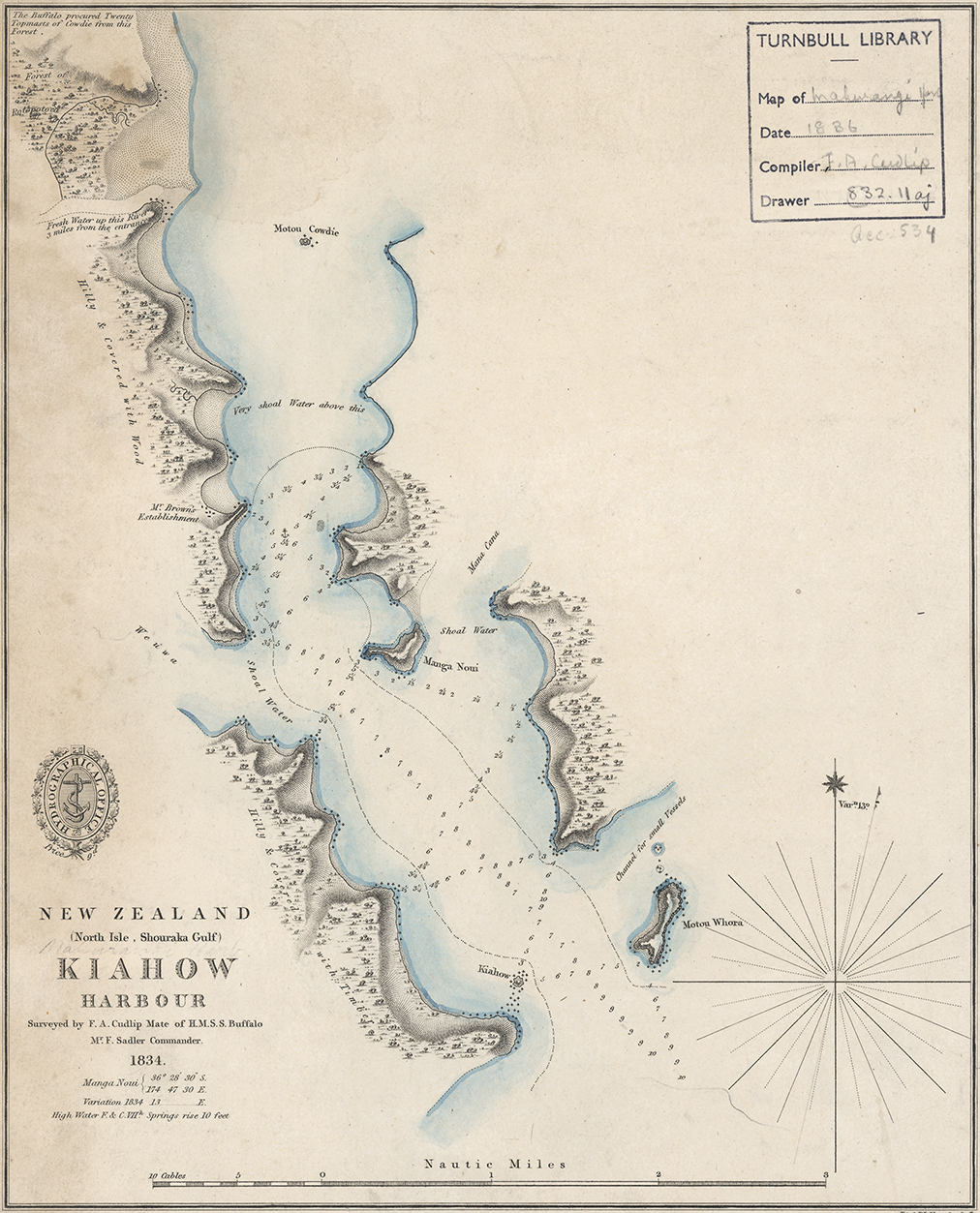
Frank A Cudlip’s chart showing “Mr Brown’s Establishment” at Mahurangi Harbour, here referred to as Kaihow—the name of the small sea stack at the harbour entrance, and possibly, then, also used for the lower harbour. chart Frank A Cudlip, 1834| caption Mahurangi Magazine
As well as exploiting the timber resources at Mahurangi, the Buffalo was also busy making a detailed chart of the harbour, no doubt to facilitate future visits. This work was carried out by the first mate of the Buffalo, F.A. Cudlip, and as published by the Hydrographical Office of the Admiralty two years later, in 1836. “Mr Browne’s Establishment” is marked, which is perhaps some evidence that it was regarded by the Navy as a permanent resource. The land behind the sawmill is described as “hilly and covered with wood”, and at the top left-hand corner of the chart is recorded “The Buffalo procured twenty Topmasts of CowdrieAn Anglicisation of “kauri” from this forest”. In early 1835, Gordon was visited at Mahurangi by his brother Major Charles Browne, who was on sick leave from his post with the Madras Infantry in India. In a detailed letterCharles Gordon Browne transcribes the whole of this letter, presumably copied from the original. There is also a copy in New Zealand’s Mercury Bay Museum. According to Brassey, this important letter is the only source for a number of observations, including in its physical description of the facilities erected by Gordon Browne and his workforce at Mahurangi. to his Aunt Ann Moxon (of The Lodge at Twickenham), written from Sydney in June 1835, Charles Browne describes Gordon Browne’s situation in some detail. An extract follows:
Windsor New South Wales 5th June 1835 You will have heard from my dear mother that I was compelled by ill-health to quit India in the early part of last year, and that I determined upon availing myself of the opportunity to seek out my brother Gordon in New Zealand. I reached his little settlement in January [1835] and remained with him until the end of March. I hardly know how to describe to you the situation in which I found him, for there is nothing around you in our favoured England to which I can at all liken it. He is located upon the shore of an inlet of the Firth of Thames, about 90 miles southward from the Bay of Islands. His settlement consists of a small plank hut and store, a dozen rush cottages, a large timber yard, and a couple of saw pits, scattered along the beach of the inlet which have formed a pretty little bay—the background rising up from the beach into gently sloping hills covered with forest and fern, picturesque enough, but wild, and on a rainy day rather gloomy and comfortless. At this settlement are three or four sawyers etc and a boat’s crew of New Zealanders. The rest of Gordon’s people, comprising about 100 Natives, and 15 or 20 Europeans and Americans are away in the Bush, as the forest is there styled, felling and squaring timbers. All around is dreary Bush or fern—there is not a human habitation within 50 miles in any direction. The only communication with the Bay of Islands is by seaThe journey between Mahurangi and the Bay of Islands often took at least 10 days, depending on the size of the vessel, and the weather., and it is seldom had oftener than once in three or four months—so it may be considered as entirely shut out of the civilised world. He has no society—no-one with whom he can converse. The New Zealanders indeed he is obliged to admit to a considerable freedom of intercourse. I assure you from the little experience I have of their manners I would altogether prefer perfect solitude—constant association with these untutored savages is exceedingly unpleasant and involves an incessant and most wearying exercise of patience to be borne. Of the privations and hardships to which he has been and still must be exposed I can hardly give you a right conception without going into much more of detail than would suit my limits. In the earlier period of his residence at Mahurangi he was frequently for weeks together reduced to live just as the savages themselves—fern root and shell fish for his food—the latter gathered with his own hands as the tide might allow—and a small rush hovel for his habitation. Few in fact have endured greater bodily suffering and distress than he has been called upon to encounter. Add to this that humanly judging his life has hung as it were upon the mere caprice of savages around him. But God has mercifully kept him. My boyish recollection of Gordon had led me to think of him as delicate and weakly and quite unfitted to endure much of hardness—I found him now altogether the reverse, very delicate indeed in appearance, but capable of bearing much fatigue and imbued with abundant perseverance to overcome all obstacles. He speaks the language of the New Zealanders fluently and has acquired considerable influence among the Chiefs, but this so far from reconciling me to the idea of his staying in this land only makes me more earnestly desire that he should quit it, because I feel that no man bearing the name of Christ can be justified in remaining among them otherwise than as a witness for Christ, and that I fear no man can be, at present at least who is not avowedly a Missionary—the European who settles here for trading purposes being generally obliged, for the attainment of his object, to allow of practices quite inconsistent with the Gospel…Here CGB indicates that a passage has been omitted from his transcription of Charles’ letter. The omitted passage may consist of religious musings, or examples of “practices quite inconsistent with the Gospel”, and/or (possibly) to Gordon’s domestic arrangements with Jess. I hope however he will not need to remain much longer in his savage exile, and if he should be permitted to revisit his native land, he will be able to narrate for himself all that he has seen and learned amongst the barbarous but very interesting people among whom he has so long sojourned.
Ever your affection nephew CA Browne
The privations suffered by Gordon Browne at Mahurangi are confirmed by Wigglesworth, who explains that warfare amongst the indigenous people had depleted local food supplies, with the result that “Europeans were often forced to survive on fern roots”, although “despite these difficulties the first cargo of 43 masts and 238 loads of timber was ready to be sent [from Mahurangi] to London by August 1833”. However it seems that the availability of palatable food was not always maintained. Wigglesworth also records that by about 1835 the effect of Gordon’s responsibilities “proved disastrous for his health and he was only seven stone in weightSee Wigglesworth p. 126. No source is cited for this information.”.
Not long after Charles Browne’s visit, Dacre and Browne set about shifting the entire spar and timber venture from Mahurangi to Mercury Bay, which had been the site of Dacre’s earliest New Zealand operations. For a time Gordon Browne was managing timber extraction at both Mahurangi and Whitianga and probably elsewhere, before the Mahurangi station was finally closed down in 1836see Wigglesworth p. 131.
In addition to forest land, Browne bought land for grazing cattle between Whitianga and the Purangi River. The consideration, paid to one Taharake, on 27 October 1837, was:
…16 pounds cash, 36 Sydney pieces worth 3 pounds each, 24 blankets, 10 tents, 10 hats, 20 tomahawks, 20 tinder boxes, 20 boxes of lucifersmatches, 10 pairs of scissors, 10 looking glasses, 3 sixty pound boxes of tobacco, 140 pounds in Spanish dollars, and articles of merchandise”. The land was originally known as Browne’s Grant but subsequently formed part of Dacre’s land claims, eventually settled in 1862. The former tract of grazing land is now known as Flaxmill Bay. Today the post-settlement history of the area is commemorated for the benefit of visiting tourists by a large sign marked Dacre’s Grant, which recites the consideration originally paid by Browne See https://partofpastnzhistory.blogspot.com/2014/12.
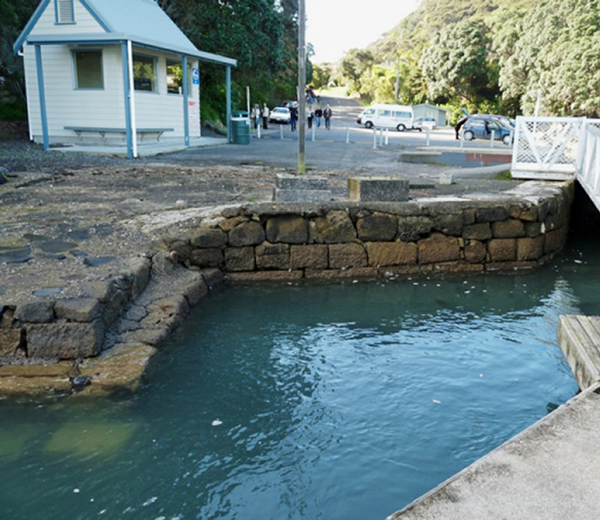
Ferry Landing for 181 Years: Built by Gordon Browne in 1838, this stone wharf used by the passenger ferry from Whitianga is thought to be the oldest wharf structure still in use in New Zealand. image The Moxon Brownes
Gordon Browne carried out extensive, and expensive, building work at Whitianga, including constructing a water-powered sawmill and a stone jetty. The jetty, of unmortared stone blocks dressed by local Māori labour, is still in use today, as a ferry landing known as Browne’s wharf. It is said to be the first construction of its kind in New Zealand, and is today Category 1-listedList No. 4675 by Heritage New Zealand.
The total cost of the works carried out by Gordon Browne at Whitianga was said, by Dacre, to amount to £4000about £400,000 in today’s money. There were also other substantial expenses, as well as trading losses. According to Dacre’s evidence to the Land Claims Courtsee evidence of Ranulph Dacre in Court of Land Claims 28 June 1862 in 1862, his accounts for 1838 showed a total loss of £9100about £1m in today’s money. It is possible that these figures were exaggerated, in the context of justifying Dacre’s claim to land originally acquired by Browne.
Between 1842–4 Dacre, who had extensive business interests in Australia as well as New Zealand, became insolvent as a result of an economic depression in Australia, and was obliged to sell all his assets, although he was subsequently to re-establish himself. Amidst what appears to have been considerable financial confusion, the timber business at Whitianga eventually passed into other hands. Meanwhile Gordon Browne did not fare well. The years of privation, overwork and financial difficulties were taking their toll on a man who may have had a pre-existing vulnerability to mental disorder. It is apparent from Charles Browne’s letter to his Aunt Ann in 1835, quoted above, that Charles was worried about his brother; and it may have been his reports, or similar stories from other sources, which prompted Gordon’s younger brother Octavius to visit him in October 1839, while Octavius was on his way to Australia.
As related in Chapter 2 above, Octavius’s time in New Zealand was described by him in a very long letter to his cousin Eliza Moxon in England, dated 3 February 1842. This letter was written at sea, en route from Sydney to Calcutta, and paints a detailed picture of Octavius’s travelsThe whole of this very long letter was transcribed by Octavius’ son CGB in 1903, occupying over 40 manuscript pages, presumably being copied by CGB from the original. The eColenso article, Who was Octavius Browne? also quotes from this letter, giving it the reference ATL MS Papers—0932; so it would seem that Charles Gordon Browne’s transcription is not the only copy of it. over the previous two years in both New Zealand and Australia. Octavius mentions meeting up with Gordon, and describes his situation in New Zealand thus:
I was five months in New Zealand altogether—travelling most of the time in this almost impenetrable country of mountain and flood, forest and fernhills, streams & swamps. The “prestige” of Gordon’s name did more for me than the best letter of recommendation would have effected among the civilised and polite. I received a courteous welcome from the Chiefs wherever I went, and the name bestowed on me of “the Brother”of Kiore. Kiore is the te reo Māori word for the Pacific rat, Rattus exulans. Octavius reports that this name was given to Gordon by the Māori, while he (Octavius) was called Okitawio. One source (e Colenso: Who was Octavius Browne?) postulates that Kiore was an approximation of “Gordon” in the Māori tongue, while Brassey assumes that the name Kiore was given to the diminutive and probably chronically under-nourished Gordon because he looked like a rat. It seems likely that both are right, and the name was a Māori pun alluding both to Gordon’s European name, and his physical appearance. while it established my rank & dignity among them, shows how great a man he must be, since to be under him was so much.
However, it was obvious all was not well. Later in the same letter, Octavius gives a clue as to Gordon’s declining mental health. He describes the paying-off of some of Gordon’s workmen on Christmas Eve in 1839:
The whole Tribe, men, women & children assembled to receive payment from Kiore for some spars—here I first saw some of my Bales & Boxes etc with the Scarlet Blankets, Prints etc which I had shipped from England—Gordon threw them to the Chief, and he distributed the articles to his people; an interesting sight no doubt for an Xmas eve, if I had not known very well that I should never be paid for any Goods, but poor Kiore seemed quite unconscious that they were mine, or of the loss he was inflicting on me—this was a very clear sight to me indeed, but I could not help myself, I would not fret, though between the seriousness and the strange novelty of the scene I must have smiled most ruefully.
Octavius makes no further mention of Gordon’s problems in this letter, perhaps in order to avoid causing distress to his family in England.

Followed to Whitianga: On her third and final visit to Aotearoa, hmss Buffalo met her end on the eponymous beach where Browne and Dacre had made their second attempt to establish a viable spar station. marine artist Paul Deacon | caption Mahurangi Magazine
In July 1840 Gordon had another encounter with hmss Buffalo, the ship which had caused him such trouble six years earlier, when the Navy commandeered some of his timber stocks at Mahurangi. The Buffalo was visiting Browne’s operation at Mercury Bay, again in search of kauri spars for the navy’s use. This time, events turned out differently. While awaiting loading, the Buffalo was caught in a hurricane, dragging her anchors and eventually breaking up at a place known today as Buffalo Beach, where the ribs of the ship can occasionally still be seen at low tides. Two lives were lost in this incident, which was long remembered in New Zealand, and has been the subject of numerous dramatic paintings by local artists.
After New Zealand’s sovereignty was established by the Treaty of Waitangi in 1840, Gordon Browne submitted five land claims, to be heard in New Zealand by a newly- appointed commissioner. Claims 2–4 concerned land at Mercury Bay, which Gordon had originally “bought” for or with assistance from Ranulph DacreBrassey, writing in the Mahurangi Magazine about Gordon Browne and his Spa Station, says that the claims document has been altered in manuscript, which he postulates was done by Dacre. However it seems at least as likely that this was done by Octavius, who was certainly involved in some way in helping Gordon with these claims.. When subsequently giving evidence to the Land Claims Court, in 1862, Dacre claimed that in 1841 he had:
…paid £200 to collect the native evidence to substantiate Gordon Browne’s purchases, which evidence was given before the commissioners … [ and ] I referred especially to the establishment at Mercury Bay being the property not of Mr Gordon Browne alone, but mine also…
Dacre then continued:
…in accordance with the chain of events I have above stated on oath, I claim to be entitled in equity to the land comprised in the grants made out in the name of Gordon Browne for 1200 acres and 1875 acres at Mercury Bay dated 1st February 1845, on payment of survey and other fees.
Other claims by Browne in 1841 appear to have been unsuccessful, probably partly because by this time Gordon had become incapable of giving any coherent account of the circumstances of his acquisitions. In the course of 1840, his mental health had declined rapidly, and in September of that year Dr Alexander Lane, formerly the ship’s surgeon aboard hmss Buffalo, certified that he was insane, and had for six months past been incapable of managing his affairs.
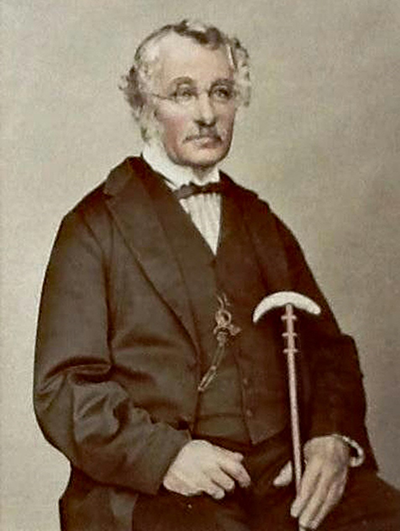
Dr Samuel Hayward Ford, who attended Gordon Browne in his last days at the Bay of Islands image The Moxon Brownes
The doctor’s description of Gordon’s condition makes for painful reading, but is worth reproducing, as primary evidence from a professionally qualified source that Gordon had by this time completely lost his mind, rather than, for example, suffering from temporary mood swings or depression:
Sir, Agreeable to your request I now send you my opinion regarding the state of Mr Browne’s mind. He is labouring under “Melancholia Religiosa” and has been incapable of managing his own affairs for at least the last six months—he told me that he was a Prophet, that the Holy Ghost slept with him every night, and that during the day the Almighty was under one side of his cloak and the Holy Ghost under the other—that there was a curse upon him until certain of his Houses were pulled down as the place was Holy Ground—that he had been for some time annoyed by two little Boys, but that he got rid of them by sending them through a loaf of bread and the side of the House—he said that Lord had given all the world to Christianity and that he would make the Blacks White all speaking the same language when the Millennium should commence—that the sea should become fresh to the depth of forty feet—that he had the power of restoring life and that Mr Woods stuffed birds should have life when he arrived in England—these and many other absurd notions regarding things in general are too evident proofs of derangement of the intellectual faculties rendering it unsafe for Mr Browne to be at large, more particularly as he twice set fire to his house, and as he frequently wanders to a great distance from home he should be very closely watched. I trust his brother will soon arrive so that he may be put in a place of safety, and under proper restraint where there may be a possibility of his future recovery under judicious medical treatment.
I am your most obedient Alexander Lane, MD, Surgeon Royal Navy and of her Majesty’s late ship BuffaloSee Brassey, citing Dr Lane’s Memo from Encampment Buffalo Beach, Mercury Bay 14 September 1840 Folio 46/100 (Dacre file 1A 1 1851/1588, Archives of New Zealand, Wellington)..
Octavius had by this time left New Zealand for Sydney, Australia; but he continued to try to ensure that Gordon was properly looked after, as shown by his correspondence with Gilbert MairSee Sir George Grey Special Collections, Auckland City Library NZMS 184–184., a prominent New Zealand trader then living at Te Wahapu in the Bay of Islands. On 25 March 1841, Octavius wrote:
…I am happy to inform you that arrangements will soon I trust be concluded respecting my poor Brother, and his affairs, as I hope, will be attended with the best result, with God’s blessing.
With kindness, quiet, wholesome diet, and regular habits under Mrs Swayne’s care, with a friend or two to see him now and then, I entertain great hopes that his malady which seems to be a religious melancholy, will gradually be reversed.
The arrangements whereby Gordon was to be put into the care of Mrs Swayne at the Bay of Islands were put into effect, although Gordon’s journey there from Mercury Bay was perilous. On 6 July 1841, Gilbert Mair wrote to Octavius from Te Wahapu:
I wrote you a few hurried lines some time back which I trust you received. Your poor Brother Gordon came up last week from Mercury Bay, he was 32 days on his passage up in a little thing belonging to Webster. He sent your brother on board without putting so much as little Tea or Sugar or even meatWebster was an American who arrived in New Zealand in 1835 and worked with Gordon Browne at Whitianga, eventually taking over the station amongst other timber operations after Gordon Browne became incapable.
Webster also acquired other commercial interests in New Zealand, although he appears to have lost money. He may have been a generally rather unreliable character, as perhaps indicated by Gilbert Mair’s letter. See Dictionary of New Zealand Biography—Te Ara: William Webster., when he landed on my beach he could hardly stand, I shall endeavour to give you as near an account of him as I can. He landed at my place in the morning and in the afternoon I took him up to Mrs Swains. I have not seen him since but have heard from him every other day since he went up, he is regaining his strength very much. I have furnished him with clothes and every thing he requires. Two of his Natives came up with him one of them has been with him many years but I am afraid they will not remain in the Bay as they want to go back. He cannot be left by himself as he would wander from home. One of the Natives can make him do anything—I should be very glad if he would remain to attend to him. I think you had better write to the Native and promise him some thing to remain as I have told him to stay until we hear from you. Your poor Brother is well in health but his mind is completely gone. Dr FordDr Ford was a medical doctor and missionary who had arrived in the Bay of Islands in 1835, and is accredited as New Zealand’s first resident surgeon. In the 1840s he was living at Te Wahapu, close to Gilbert Mair’s house. has promised to attend on him and do what he can for him. I have agreed to give Capt. SwainCaptain Swain, or Swayne, was a Nantucket whaling Captain who was killed by a whale in late 1844. He had land at Waikari. His death is mentioned by Mrs Marianne Williams, the missionary’s wife, in her Letters from the Bay of Islands (Penguin 2010). one hundred pounds per annum for their Trouble …
Subsequently, on 14 October 1841, Octavius wrote again to Gilbert Mair about the difficulty in unravelling Gordon’s affairs:
… no one but himself seems to be perfectly acquainted with the purchases, extent, situation or titles of his lands … My Brother’s affairs are in such an embarrassed state, and indeed seem to me to have been so very confused for many years, that I find it impossible to understand his real position, or to form any correct notion of the extent of his debts and liabilities—Capt. Dacre makes out a Balance of account against my Brother of Six thousand Pounds—I certainly do not understand how in such a business, in such a country as New Zealand, such an enormous debt can have been accumulated …
The letter continues:
… I am sorry I have not heard from Swayne, or Mr Ford—but Mr Dacre will let me and my family know from time to time how my poor Brother is—I have not written to him for a long time, because I thought it would be quite useless—I send him a few lines now however and when ever he mentions the subject, please never let him think himself neglected by any of his friends, for I can assure you they have all been anxious enough about him for years, and now are more so than ever. We must all hope the best yet …

Burial of Gordon Browne recorded in the Parish Register of Christ Church, Kororāreka image The Moxon Brownes
As we have seen, Octavius was an astute man, who later became extremely successful as a Melbourne mercantile agent. It is evident that he was suspicious about the extent of Gordon’s alleged debts. However, he does not seem to have blamed Dacre, who had a reputation for honest dealing, although at this time Dacre was himself suffering from financial difficulties. In his evidence to the Land Claims Court in 1862, Dacre described these events as follows:
Shortly after [setting up at Mercury Bay] Browne became insane. In accordance with an agreement which he had made to assign his estate to me in consideration of the large balance due by him, I sent a deed to that effect down to Mr Stewart, who was living with him at that time: but the deed was returned to me by Stewart as Browne was not in a fit state to sign it. In December 1840 I received a Medical Certificate that Browne was entirely insane and that it was necessary to remove him. He was accordingly brought away from Mercury to the Bay of Islands at my expense and there I had him placed under the care of Mrs Swain at an expense of £160 a year. During the last year of his life however his friends in England paid for his board and lodging. I paid for it during two years. He died in the year 1842, so far as I can recollect.
Dacre’s recollection some twenty years after these events is interesting. If it was necessary to try to get Browne to assign his assetsi.e. title to lands to Dacre, in consideration for cancellation of debts due, that would indicate that both in law and equity the lands were Browne’s, not Dacre’s. It seems that in truth, Dacre’s claim, at least to the Mercury Bay lands, was based on a plea that Dacre had been hard done by, and therefore deserved some recompense; rather than on any more solid legal or equitable argument.
As for Dacre’s claim that he paid for Browne to be moved from Whitianga to the Bay of Islands, and then paid for his board and lodging with Mrs Swain, this seems doubtful. Gilbert Mair’s letter to Octavius Browne quoted above asserts that it was Mair who paid for Gordon Browne to be looked after, presumably on the basis of reimbursement by the family. As related in the chapter dealing with Octavius’s life, Octavius left New Zealand for Sydney in February of 1840 with, in his words:
…all my plans completely destroyed—a great loss of money, and nothing but care and trouble before me.
Later in his letter to his cousinLetter to Eliza Moxon 3 February 1842. he says:
I have lost everything, partly by unavoidable misfortune … partly by fraud and treachery which are far more trying … but are apt to diminish one’s stock of confidence and good feeling towards others. I daresay you may have heard something of this—if not it is as well to say nothing.
It is not possible to identify exactly why Octavius felt so let down, but it is possible to speculate that he had gone to New Zealand with the intention of settling there, perhaps taking over Gordon’s role as a timber station manager; but found his plans frustrated by the extent of Gordon’s debts, and the business confusion consequent upon his mental illness.
Gordon Browne died at Waikare at the Bay of Islands, while in the care of Mrs Swayne, in January 1844, at barely 40 years of age The record of Gordon Browne’s death gives his age as “about 50”—perhaps an indication of the effect that his hard life, and latterly his illness, had on his appearance.. The exact circumstances of his death are presently unknown, although there have been suggestions, unsupported by any evidencesee footnote, that he took his own life.
Gordon’s final resting place has not been located. According to the record of his burialsee Auckland Anglican Diocese Archives, he was buried in the parish of Kororāreka at the Bay of Islands, his abode being stated as WaikariWaikare. The name of the person performing the burial ceremony is given as R BurrowsRev Robert Burrows. Rev Robert Burrows was a missionary who arrived at the Bay of Islands in 1840, and was the priest in charge of the newly-built Christ Church at Kororāreka, today celebrated as the first church to be built in New Zealandsee Rev Robert Burrows The Cyclopedia of New Zealand (Auckland Provincial District). The churchyard at Christ Church, Russell, would seem to be the most obvious place to look for Gordon’s grave, but his name does not appear to be shown by any published church records. It is possible that if Gordon did commit suicide, this might have been an obstacle to burial in consecrated ground.
On Gordon’s mind See e Colenso, Who was Octavius Browne? Writing in 1877, in his History of the Browne Family, Charles St Denys Moxon records:
When the islands were colonised systematically, the concessions of land made to [Gordon] by the natives were not allowed by our government, for want of such vouchers as they required, and this preyed on [Gordon’s] mind and led eventually to his death.
This may hint at suicide. Charles St Denys Moxon was a close friend of Octavius, who is most likely to have been his source for this information.

